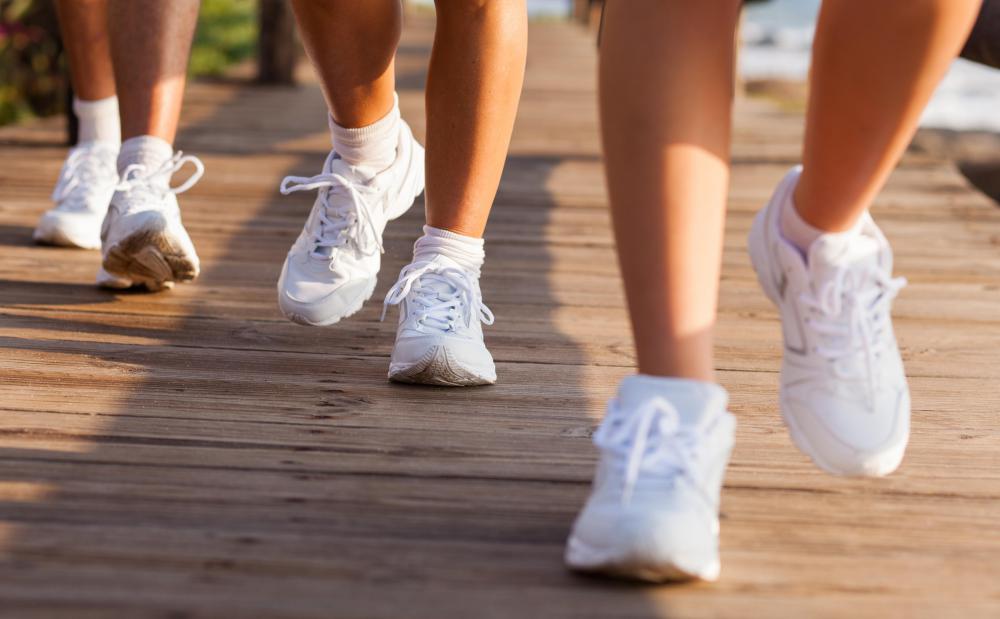At TheHealthBoard, we're committed to delivering accurate, trustworthy information. Our expert-authored content is rigorously fact-checked and sourced from credible authorities. Discover how we uphold the highest standards in providing you with reliable knowledge.
What are the Different Types of Agility Exercises?
Agility exercises are important for any athlete because they can increase balance, speed, coordination, and speed. Some of the different types of agility exercises include ladder runs, agility hurdles, and box runs. Shuttle runs, where an athlete sprints to cones of an increasing distance, can also be effective at increasing agility. Many agility exercises can be employed for all sports, although sport-specific drills are useful for improving skill levels as well as agility.
Ladder runs are one of the most popular agility exercises. To perform a ladder drill, the athlete runs over a horizontal ladder, making sure to avoid touching the sides or any of the rungs. In order to increase the difficulty of the drill, the athlete should power his or her knees upwards while running and allow the arms to swing. Ladder runs can also be performed by running sideways.

Agility hurdles are similar to ladder runs, but require the athlete to lift his or her legs over a low object. Small hurdles, about shin high, should be placed close together, and the athlete should run over them. Again, the knee should power upwards, with the arms swinging strongly. This type of agility exercise can improve footwork and increase balance, which is important for a wide range of different sports.

Box running is a different sort of agility exercise and emphasizes quick changes in direction. There are four cones setup in a square with a fifth placed in the center. The athlete starts at the center and waits for the coach or trainer to call out a number which corresponds to one of the four corner cones. He or she must sprint to that cone and back, while the coach calls out another number once the athlete is almost back to the center. The benefit of calling out the number as late as possible is that the athlete has no idea where he or she is going to turn to next. This mimics the requirements of many competitive sports.

There are a wide range of other agility exercises including lateral sprints and shuttle runs. Most agility exercises can also be made sport specific. Soccer agility exercises, for example, can assist in increasing fitness, agility, and skills if a ball is included in the drill. For agility exercises to provide the most benefit, they should be performed on a regular basis, and precision should be emphasized ahead of pure speed or strength.
AS FEATURED ON:
AS FEATURED ON:
















Discussion Comments
I played a lot of different sports when I was in school, and one of the things we always did was called karaoke. Basically, it involves you running sideways and then sidestepping while continually crossing your feet over each other. It is hard to explain, but is easy to get the hang of once you see someone do it.
We did a lot of the ladder drills, too, for speed and agility training. I always thought there were a couple of downsides to the ladder drills, though. First of all, a ladder isn't really that tall to try to jump over the rungs. Most of the difficulty lies in the fact that they rungs are close together. Also, if you trip, which is inevitable at some point, landing on a ladder can be pretty painful.
I always thought tire drills were much more challenging without the potential of landing on a metal ladder. The tires are usually taller and require you to step farther. Really, the point of the drill is to learn to high step, so the tires are more efficient all around.
@matthewc23 - We did a ton of different things when I used to play baseball. The cone drill wasn't one of them. This is actually the first time I have heard of that, but it does sound like it would be effective.
Maybe something you could do to make it more baseball oriented would be to yell out a direction and then throw a ball that way. There are a lot of ways you could even change that. If you threw it straight in the air, it could simulate line drives. You could also do ground balls or throw the ball a little bit farther out still to make them dive for it. After they get the hang of those three things, you could start switching them up to get an even better simulation of a real game.
For outfielders, one of the best agility exercises you can do is to just keep practicing how to scoop up a ground ball while continuing to run and then throw out a runner at home. It sounds like it should be easy, but our natural inclination isn't to let the glove go all the way to the ground, because it throws off our balance.
I had never heard of the box drill. It does sound like it would be a pretty good agility training exercise. I coach a junior high baseball team, so I am constantly looking for new ways to train. It seems like that would be a very good way for infielders to practice moving when a ball is hit to them.
As far as the drill itself goes, how far should the cones be spaced apart, or is that just a judgment call about how much you want to run between the cones? Also, does anyone know of any variations on the cone drill and ways to keep it exciting? Any other suggestions people have about possible baseball agility drills would also be helpful.
@summing - I think a lot of it really just depends on the person. I was involved in sports all through high school, and I have seen plenty of agility routines that help some people and not others. Some people are naturally good at certain types of agility things and not others, so it is important to continually change up exercises. Make sure you realize what your strengths and weaknesses are and work toward improving the weaknesses.
For example, my biggest weakness is jumping and hurdling, so I always tried to push myself on those types of exercises, whether it was using higher hurdles or spacing them closer together, or whatever. On the other hand, I have always been good at things like shifting directions, so while I still practiced those things, I didn't dedicate as much time to them.
One way to measure your success may be to just do some basic exercises and record your completion times and difficulties and see where you can improve.
I have looked online and there seems to be a lot of disagreement about what methods of speed and agility training are the best. There are the classic methods which are tried and tested but also a new generation of training techniques that supposedly takes advantage of all the latest science and equipment.
Can anyone tell me from experience what training methods have worked the best for them? I want to really dedicate myself to becoming faster and more agile but if I am going to pour in the time and effort I want to know that my training is going to work. I've wasted time at the track and in gyms before. It's not worth it.
When I was in college I played on a pretty serious ultimate frisbee team and we did speed and agility drill regularly. Endurance, speed and agility are key abilities in ultimate frisbee. You have to make quick and calculated movements all over the field for an entire game.
The box drill was one of our most common drills. We also did a cutting drill and an end zone drill that both emphasized quick changes in direction. For speed training we mostly did wind sprints and and other sorts of drills where you ran with bursts of speed.
The training really helped. Physical conditioning is an often overlooked part of ultimate frisbee. Lots of guys can throw and catch a frisbee but if you can perform at a high level through the course of a physically draining game you have an immediate advantage over your opponent. The only way to get to that level is to run and run and run some more.
One of the best and most classic exercises is to run wind sprints both forwards and backward and laterally.
I played high school basketball and football and this drill was a feature of all of our early practices. It develops both agility and burst speed which are important for any athlete.
The idea is that if you work your legs out in dynamic ways and with varying spreed and directions you will improve your overall performance agility. You are stretching as you are putting your body through the kind of strain it will endure during a game. Simulating real conditions is the best way to train effectively.
Post your comments